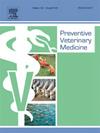Dairy farmers’ intention to use calf management technologies in four European countries: A QCA and PLS-SEM approach
IF 2.2
2区 农林科学
Q1 VETERINARY SCIENCES
引用次数: 0
Abstract
Whilst livestock management technologies may help to improve productivity, economic performance, and animal welfare on farms, there has been low uptake of technologies across farming systems and countries. This study aimed to understand dairy farmers’ intention to use calf management technologies by combining partial least squares structural equation modelling (PLS-SEM) with qualitative comparative analysis (QCA). We evaluated the hypotheses that dairy farmers will intend to use calf technologies if they have sufficient competencies, sufficient materials, and positive meanings (e.g., attitudes or emotions) towards calf technologies, and they will not intend to use technologies if one of these elements is missing. An online survey was completed by 269 dairy farmers in Belgium, the Netherlands, Norway, and the UK. A PLS-SEM was developed, where the outcome was the number of calf management technologies that the respondent intended to use, and the latent constructs included meanings, materials, and competencies. QCA was then run separately for the datasets from each country. Intention to use technologies was the outcome, whereas positive meanings, sufficient materials, and sufficient competencies for technology use were conditions in the QCA. Evaluation of the PLS-SEM showed that reliability and validity of the latent constructs was appropriate for analysis. Assessment of the structural model indicated that having positive meanings regarding technologies significantly increased the number of calf technologies the farmer intended to use (β = 0.388, CI = 0.291 – 0.486). The QCA solutions show that the conditions for the intention to use, or not use, calf technologies differed between Belgium, the Netherlands, Norway, and the UK, but the presence (or absence) of positive meanings was consistently important. The solutions for Norway and Belgium aligned with our hypotheses, but the solutions for the Netherlands and UK did not. Some of the solutions exhibited features of causal complexity such as equifinality, conjunctural causation, and asymmetric causation, which would not be able to be easily identified using traditional regression analyses. This study highlights the causal complexity of technology use on farms as a social phenomenon. Furthermore, the study shows the usefulness of QCA for evaluating theoretical hypotheses regarding farmers’ behaviour. We suggest that researchers could use this method to investigate other practices on farms that may have causal complexity.
奶农在四个欧洲国家使用小牛管理技术的意图:QCA和PLS-SEM方法。
虽然牲畜管理技术可能有助于提高农场的生产力、经济效益和动物福利,但整个农业系统和国家对这些技术的吸收程度很低。本研究旨在通过结合偏最小二乘结构方程模型(PLS-SEM)和定性比较分析(QCA)来了解奶农使用小牛管理技术的意愿。我们评估了以下假设:如果奶农有足够的能力、足够的材料和对小牛技术的积极意义(例如态度或情感),他们将打算使用小牛技术,如果这些因素之一缺失,他们将不打算使用技术。一项在线调查由比利时、荷兰、挪威和英国的269名奶农完成。开发了PLS-SEM,其结果是受访者打算使用的小牛管理技术的数量,潜在结构包括含义,材料和能力。然后对每个国家的数据集分别运行QCA。使用技术的意图是结果,而积极意义、充分的材料和充分的技术使用能力是QCA的条件。PLS-SEM的评估表明,潜在构念的信度和效度适合分析。对结构模型的评估表明,对技术具有积极意义显著增加了农民打算使用的小牛技术数量(β = 0.388, CI = 0.291 - 0.486)。QCA解决方案表明,比利时、荷兰、挪威和英国的犊牛技术意向使用或不使用的条件不同,但积极意义的存在(或不存在)始终很重要。挪威和比利时的解决方案符合我们的假设,但荷兰和英国的解决方案却不符合我们的假设。一些解决方案表现出因果复杂性的特征,如等性、联合因果关系和不对称因果关系,这些特征使用传统的回归分析不容易识别。这项研究强调了农场技术使用作为一种社会现象的因果复杂性。此外,该研究显示了QCA对评估有关农民行为的理论假设的有用性。我们建议研究人员可以使用这种方法来调查其他可能具有因果复杂性的农场实践。
本文章由计算机程序翻译,如有差异,请以英文原文为准。
求助全文
约1分钟内获得全文
求助全文
来源期刊

Preventive veterinary medicine
农林科学-兽医学
CiteScore
5.60
自引率
7.70%
发文量
184
审稿时长
3 months
期刊介绍:
Preventive Veterinary Medicine is one of the leading international resources for scientific reports on animal health programs and preventive veterinary medicine. The journal follows the guidelines for standardizing and strengthening the reporting of biomedical research which are available from the CONSORT, MOOSE, PRISMA, REFLECT, STARD, and STROBE statements. The journal focuses on:
Epidemiology of health events relevant to domestic and wild animals;
Economic impacts of epidemic and endemic animal and zoonotic diseases;
Latest methods and approaches in veterinary epidemiology;
Disease and infection control or eradication measures;
The "One Health" concept and the relationships between veterinary medicine, human health, animal-production systems, and the environment;
Development of new techniques in surveillance systems and diagnosis;
Evaluation and control of diseases in animal populations.
 求助内容:
求助内容: 应助结果提醒方式:
应助结果提醒方式:


